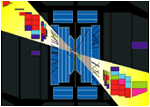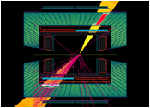
Particle tracks in a
bubble chamber detector


"Particle postcards"
from the top quark
 Particle tracks in a bubble chamber detector
|
Particle accelerators and detectors give us a way into the heart of matter at the smallest scale. In a sense, accelerators are like the most powerful microscopes ever made, allowing us to look at the smallest things human beings have ever seen.
Accelerators put the "high energy" into high-energy physics. They create beams of billions of particles with enormous concentrated energy, moving at nearly the speed of light. When the particles collide, a burst of energy creates a profusion of new particles (E = mc2) for physicists to analyze.
Detectors are the eyes of the system. They act like huge, 5,000-ton cameras, snapping a million particle-collision portraits a second and saving the most interesting ones for future study.
The first accelerators in the early 1930's were only a few inches in diameter. Today, some accelerators are big enough to encircle a medium-sized town. At a handful of laboratories around the world, the beams of these extraordinary machines illuminate the subatomic world.
Perhaps more than in any other field, advances in particle physics depend on the advancing technology of the tools of research. An important part of the science of high-energy physics is the never-ending development of accelerator and detector technology to reach ever higher energies.